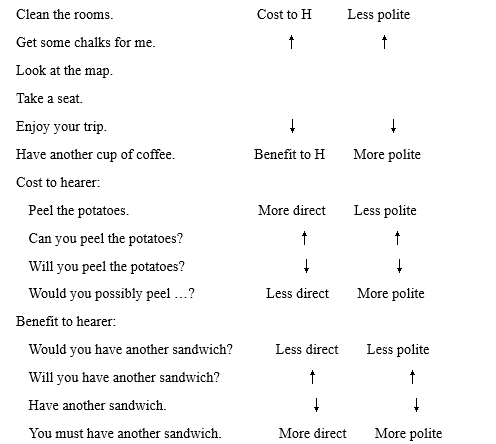知识点二:The politeness principle (PP)
I.Politeness as a universal phenomenon
1. Definition
Leech points out that CP in itself cannot explain why people are often so indirect in conveying what they mean. Grice’s theory of CP is, fundamentally, logic-oriented. Conversational interaction is also social behavior. Choice of linguistic codes is central in language use. There are social and psychological factors that determine the choice.
Brown and Levinson point out that politeness is a universal phenomenon in social interaction in all cultures. An important concept concerning politeness is that of face, which is the negotiated public image, mutually granted each other by participants in a communicative event. Politeness can be defined as the means employed to show awareness off another person’s face. It is an act performed to respect the face of others is considered to be polite, otherwise it is impolite.
2. Classification of politeness
Brown and Levinson classify the notion of face into two types: the negative face and the positive face. The former refers to the need to be independent, to have freedom of action, and not to be imposed on by others. The latter is the need to be accepted by others to be treated as a member of the same group and to know that one’s wants are shared by others.
Thus the negative politeness and positive politeness are derived. Negative politeness tends to show deference and emphasize the importance of other’s time and concerns and even include an apology for the imposition or interruption. Positive politeness is concerned with the participants’ positive face. Participants will tend to show solidarity, emphasizing that both the interlocutors want the same thing, and that they have a common goal.
II. The politeness principle
Besides being cooperative, participants of conversations normally try to be polite. The speakers consider the matter of face for themselves and others. Based on this observation, Leech proposes the politeness principle (PP), which contains six maxims.
Tact
Minimize cost to other.
Maximize benefit to other.
Generosity
Minimize benefit to self.
Maximize cost to self.
Approbation
Minimize dispraise of other.
Maximize praise of other.
Modesty
Minimize praise of self.
Maximize dispraise of self.
Agreement
Minimize disagreement between self and other.
Maximize agreement between self and other.
Sympathy
Minimize antipathy between self and other.
Maximize sympathy between self and other.
III. Scales of politeness
The maxims expressed in terms of maximize and minimize entail the concept of guidance in politeness. The tact maxim expressed in terms of cost and benefit can be exemplified by the following:

The existence of degree of politeness allows for choice on the part speaker. As a linguistic interaction is necessarily a social one, the choice is also largely determined by social factors.
IV. Social variables in politeness
Politeness is also related to such social variables as social distance, social power or authority, as well as gender and age, with the first two being most distinct and recognizable in social interactions.
Previous studies of politeness in relation to social factor have found that the more remote the social distance between the interlocutors is, the more polite the Linguistic expressions tend to be.
Age and gender are also social factors closely related to politeness in communication. Empirical studies have shown that we tend to be more polite talking with the elderly than with our peers. Women are sensitive to the face needs of others while men’s speech is more matter-of-fact.
V. Cultural difference in politeness
An act may be polite, but may not be polite at all in another. And also, an act performed in one manner may be polite in one culture, but may be quite impolite if performed in the same manner in another culture. To different cultures, the nature of politeness, together with its maxims, is more or less diversified. Thus politeness shows great relativity and diversity in different cultures.
Let’s do some exercise.
